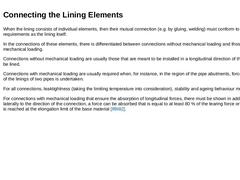
|
When the lining consists of individual elements, then their mutual connection (e.g. by gluing, welding) must conform to the same requirements as the lining itself. In the connections of these elements, there is differentiated between connections without mechanical loading and those with mechanical loading. Connections without mechanical loading are usually those that are meant to be installed in a longitudinal direction of the structures to be lined. |
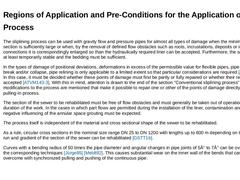
|
The sliplining process can be used with gravity flow and pressure pipes for almost all types of damage when the minimum free cross section is sufficiently large or when, by the removal of defined flow obstacles such as roots, incrustations, deposits or intruding connections it is correspondingly enlarged so than the hydraulically required liner can be accepted. Furthermore, the sewer must be at least temporarily stable and the bedding must be sufficient. |
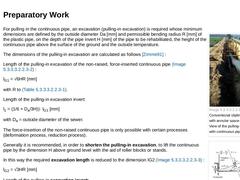
|
|
(Image: Conventional sliplining process with annular space [FI-Teerb] - View of the pulling-in excavation with continuous pipe)
|
|
(Image: Calculating the dimensions of the pulling-in excavation - Length of the pulling-in excavation for forced guiding with non-raised continuous pipe [Zimme91])
|
|
(Image: Calculating the dimensions of the pulling-in excavation - Bending curve of the continuous pipe raised by the amount H [Zimme91])
|
|
(Image: Calculating … |
|
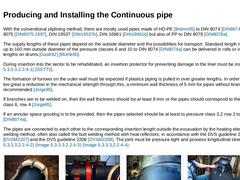
|
With the conventional sliplining method, there are mostly used pipes made of HD-PE [Bröms95] to DIN 8074 [DIN8074a] and DIN 8075 [DIN8075:1997], DIN 19537 [DIN19537b], DIN 16961 [DIN16961b] but also of PP to DIN 8078 [DIN8078a]. The supply lengths of these pipes depend on the outside diameter and the possibilities for transport. Standard length is 12 m. Pipes up to 160 mm outside diameter of the pressure classes 6 and 10 to DIN 8074 [DIN8074a] can … |
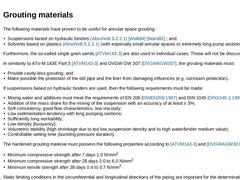
|
The following materials have proven to be useful for annular space grouting: - Suspensions based on hydraulic binders (Abschnitt 5.2.2.1) [Walli84] [Ward82] ; and
- Solvents based on plastics (Abschnitt 5.2.2.1) (with especially small annular spaces or extremely long pump sections).
Furthermore, the so-called single grain sands [ATVM143-3] are also used in individual cases. These will not be discussed further. In similarity to ATV-M 143E Part 3 [ATVM143-… |
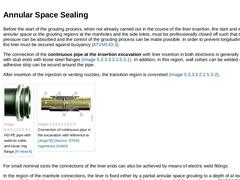
|
Before the start of the grouting process, when not already carried out in the course of the liner insertion, the start and ends of the annular space or the grouting regions at the manholes and the side inlets, must be professionally closed off such that the grouting pressure can be absorbed and the control of the grouting process can be made possible. In order to prevent longitudinal changes, the liner must be secured against buoyancy [ATVM143-3]. |
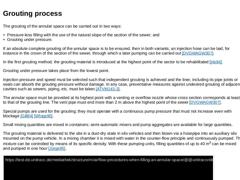
|
The grouting of the annular space can be carried out in two ways: -
Pressure-less filling with the use of the natural slope of the section of the sewer; and
-
Grouting under pressure.
If an absolute complete grouting of the annular space is to be ensured, then in both variants, an injection hose can be laid, for instance in the crown of the section of the sewer, through which a later pumping can be carried out [DVGWAGW307].
In the first grouting method, … |
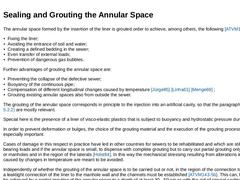
|
The annular space formed by the insertion of the liner is grouted order to achieve, among others, the following [ATVM143-3] : - Fixing the liner;
- Avoiding the entrance of soil and water;
- Creating a defined bedding in the sewer;
- Even transfer of external loads;
- Prevention of dangerous gas bubbles.
Further advantages of grouting the annular space are: - Preventing the collapse of the defective sewer;
- Buoyancy of the continuous pipe;
- Compensation of different …
|
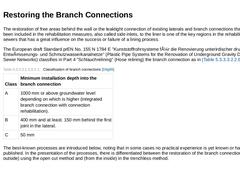
|
The restoration of free areas behind the wall or the leaktight connection of existing laterals and branch connections that have not been included in the rehabilitation measures, also called side inlets, to the liner is one of the key regions in the rehabilitation of sewers that has a great influence on the success or failure of a lining process. The European draft Standard prEN No. 155 N 1784 E "Kunststoffrohrsysteme für die Renovierung unterirdischer … |
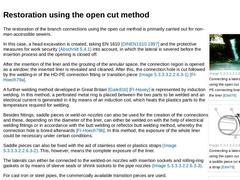
|
|
(Image: Connecting a lateral to the liner using the open cut method - HD-PE connecting branch welded to the liner [Ettel76])
|
|
(Image: Connecting a lateral to the liner using the open cut method - Fixing a saddle piece on to the liner with a strap [Ettel76])
|
|
(Image: Connecting a lateral to the liner by means of a welded-in plastics pipe and shrink socket with reference to [WRC83] [Image: S&P GmbH])
|
The restoration of the branch connections using … |
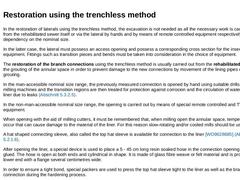
|
In the restoration of laterals using the trenchless method, the excavation is not needed as all the necessary work is carried out either from the rehabilitated sewer itself or via the lateral by hands and by means of remote controlled equipment respectively in dependency on the nominal size. In the latter case, the lateral must possess an access opening and possess a corresponding cross section for the insertion of the equipment. Fittings such as … |
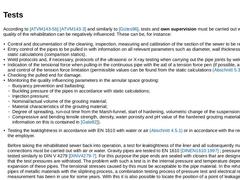
|
According to [ATVM143-5b] [ATVM143-3] and similarly to [Gütes96], tests and own supervision must be carried out wherever the quality of the rehabilitation can be negatively influenced. These can be, for instance: - Control and documentation of the cleaning, inspection, measuring and calibration of the section of the sewer to be rehabilitated.
- Entry control of the pipes to be pulled in with information on all relevant parameters such as diameter, wall …
|
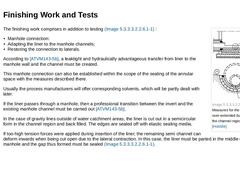
|
(Image: Measures for the relief of the liner over-extended during pulling-in in the channel region of the manhole [Holst84]) The finishing work comprises in addition to testing (Bild 5.3.2.2) : - Manhole connection:
- Adapting the liner to the manhole channels;
- Restoring the connection to laterals.
According to [ATVM143-5b], a leaktight and hydraulically advantageous transfer from liner to the manhole wall and the channel must be created. This manhole connection … |
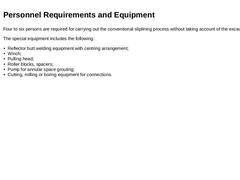
|
Four to six persons are required for carrying out the conventional sliplining process without taking account of the excavation work. The special equipment includes the following: - Reflector butt welding equipment with centring arrangement;
- Winch;
- Pulling head;
- Roller blocks, spacers;
- Pump for annular space grouting;
- Cutting, milling or boring equipment for connections.
|
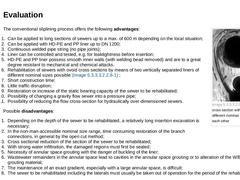
|
(Image: Ovoid cross section with two inliners of different nominal sizes above each other) The conventional sliplining process offers the following advantages: - Can be applied to long sections of sewers up to a max. of 600 m depending on the local situation;
- Can be applied with HD-PE and PP liner up to DN 1200;
- Continuous welded pipe string (no pipe joints);
- Liner can be controlled and tested, e.g. for leaktightness before insertion;
- HD-PE and PP liner …
|
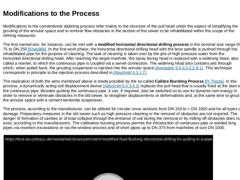
|
Modifications to the conventional sliplining process refer mainly to the structure of the pull head under the aspect of simplifying the grouting of the annular space and to remove flow obstacles in the section of the sewer to be rehabilitated within the scope of the relining measures.
The first named aim, for instance, can be met with a modified horizontal directional drilling process in the nominal size range DN 75 to DN 250 [Kleis96b]. In the first … |
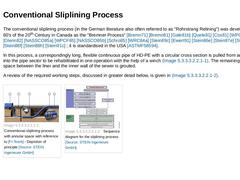
|
The conventional sliplining process (in the German literature also often referred to as "Rohrstrang Relining") was developed in the 60's of the 20th Century in Canada as the "Bremner Process" [Bremn71] [Bremn81] [Gale81b] [Quele81] [Cox81] [WPCFFD6] [Glenn82] [NASSCO85a] [WPCF85]
[NASSCO85b] [Schro85] [WRC84a] [Stein89c] [Ewert91] [Stein86e] [Stein87e] [Stein87f] [Stein88f] [Stein88h] [Stein91c] ; it is standardised in the USA [ASTMF58594]. In this … |
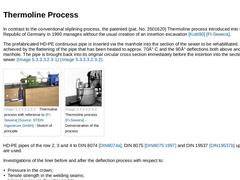
|
In contrast to the conventional sliplining process, the patented (pat. No. 3501620) Thermoline process introduced into the Federal Republic of Germany in 1990 manages without the usual creation of an insertion excavation [Kutti90] [FI-Sewera]. The prefabricated HD-PE continuous pipe is inserted via the manhole into the section of the sewer to be rehabilitated. This is achieved by the flattening of the pipe that has been heated to approx. 70° C and … |
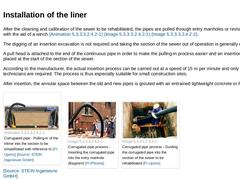
|
After the cleaning and calibration of the sewer to be rehabilitated, the pipes are pulled through entry manholes or revision openings with the aid of a winch (Abschnitt 5.3.2.2.1.3.1) (Bild 5.3.2.2.1.3.1) (Bild 5.3.2.2.1.3.1). The digging of an insertion excavation is not required and taking the section of the sewer out of operation is generally not necessary. A pull head is attached to the end of the continuous pipe in order to make the pulling-in … |
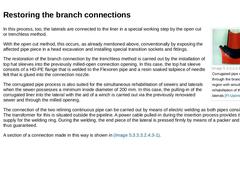
|
(Image: Corrugated pipe method: Section through the branch connection region with simultaneous rehabilitation of the sewer and laterals [FI-Upono]) In this process, too, the laterals are connected to the liner in a special working step by the open cut or trenchless method. With the open cut method, this occurs, as already mentioned above, conventionally by exposing the affected pipe piece in a head excavation and installing special transition sockets … |
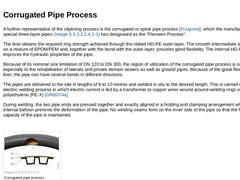
|
A further representative of the sliplining process is the corrugated or spiral pipe process [FI-Upono], which the manufacturer of the special three-layer pipes (Bild 5.3.2.2.1.3) has designated as the "Flexoren Process". The liner obtains the required ring strength achieved through the ribbed HD-PE outer layer. The smooth intermediate layer is based on a mixture of EPDM/PEM and, together with the bond with the outer layer, provides good flexibility. … |
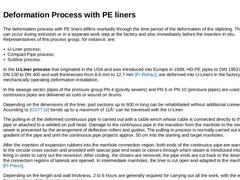
|
The deformation process with PE liners differs markedly through the time period of the deformation of the sliplining. This deformation can occur during extrusion or in a separate work step at the factory and also immediately before the insertion in situ. Representatives of this process group, for instance, are: - U-Liner process;
- Compact Pipe process;
- Subline process.
In the U-Liner process that originated in the USA and was introduced into Europe in … |
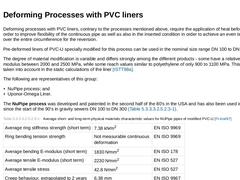
|
Deforming processes with PVC liners, contrary to the processes mentioned above, require the application of heat before insertion in order to improve flexibility of the continuous pipe as well as also in the inserted condition in order to achieve an even temperature over the entire circumference for the reversion. Pre-deformed liners of PVC-U specially modified for this process can be used in the nominal size range DN 100 to DN 450. The degree of material … |
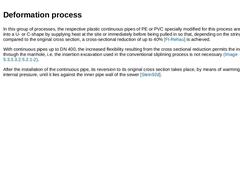
|
In this group of processes, the respective plastic continuous pipes of PE or PVC specially modified for this process are predeformed into a U- or C-shape by supplying heat at the site or immediately before being pulled in so that, depending on the string diameter compared to the original cross section, a cross-sectional reduction of up to 40% [FI-Rehau] is achieved. With continuous pipes up to DN 400, the increased flexibility resulting from the cross … |
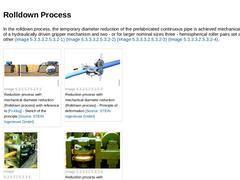
|
In the rolldown process, the temporary diameter reduction of the prefabricated continuous pipe is achieved mechanically with the aid of a hydraulically driven gripper mechanism and two - or for larger nominal sizes three - hemispherical roller pairs set at 90° to each other (Bild 5.3.2.2.1.4.2.1) (Bild 5.3.2.2.1.4.2.1) (Bild 5.3.2.2.1.4.2.1) (Bild 5.3.2.2.1.4.2.1). |
(Image: Reduction process with mechanical diameter reduction (Rolldown process) with … |
|